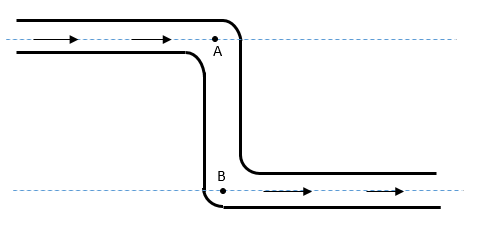
In the figure, an ideal liquid flows through the tube, which is of uniform cross section. The liquid has velocities \[{v_A}\] and \[{v_B}\], and pressure \[{P_A}\]and \[{P_B}\] at the points A and B respectively. Then;

A. \[{v_A} = {v_B}\]
B. \[{v_A} > {v_B}\]
C. \[{P_A} = {P_B}\]
D. \[{P_B} > {P_A}\]
Answer
219.6k+ views
Hint:The rate of flow of the liquid in a tube is constant and it is the product of the speed of flow and the area of cross-section. When there is pressure difference then the fluid starts flowing in the direction from the region of higher pressure to the lower pressure.
Formula used:
\[Q = Av\]
where Q is the rate of flow, A is the area of cross-section and v is the speed of flow.
\[P + \dfrac{{\rho {v^2}}}{2} + \rho gh = cons\tan t\],
This is called Bernoulli's theorem of conservation of energy.
Complete step by step solution:

Image: Liquid flows through the pipe
For the point A, let the velocity of flow is \[{v_A}\], the pressure is \[{P_A}\] and the area of cross-section is \[{A_A}\] and the height from the ground level is \[{h_A}\]. Then the rate of flow of fluid is,
\[{Q_A} = {A_A}{v_A}\]
For the point B, let the velocity of flow is \[{v_B}\], the pressure is \[{P_B}\] and the area of cross-section is \[{A_B}\] and the height from the ground level is \[{h_B}\]. Then the rate of flow of fluid is,
\[{Q_B} = {A_B}{v_B}\]
As the cross-section of the pipe is uniform throughout the length of the pipe,
\[{A_A} = {A_B}\]
And using the continuity equation, the rate of flow of the fluid at both the points is same,
\[{Q_A} = {Q_B}\]
\[\Rightarrow {A_A}{v_A} = {A_B}{v_B}\]
\[\Rightarrow {v_A} = {v_B}\]
Now, using the Bernoulli’s equation for both the points, we get
\[{P_A} + \dfrac{{\rho v_A^2}}{2} + \rho g{h_A} = {P_B} + \dfrac{{\rho v_B^2}}{2} + \rho g{h_B}\]
\[\Rightarrow {P_A} = {P_B} + \rho g\left( {{h_B} - {h_A}} \right)\]
\[\Rightarrow {P_A} = {P_B} + \rho g\left( {0 - {h_A}} \right)\]
\[\Rightarrow {P_A} = {P_B} - \rho g{h_A}\]
\[\therefore {P_A} < {P_B}\]
So, the pressure at point B is greater than pressure at A.
Therefore, the correct option is D.
Note: The gravitational potential energy of the fluid at A is greater than the gravitational potential energy of the fluid at B. when the fluid moves from A to B then the gravitational potential energy transformed to the pressure energy of the fluid because the kinetic energy is same at both the points. And hence, the energy at both the points is the same.
Formula used:
\[Q = Av\]
where Q is the rate of flow, A is the area of cross-section and v is the speed of flow.
\[P + \dfrac{{\rho {v^2}}}{2} + \rho gh = cons\tan t\],
This is called Bernoulli's theorem of conservation of energy.
Complete step by step solution:

Image: Liquid flows through the pipe
For the point A, let the velocity of flow is \[{v_A}\], the pressure is \[{P_A}\] and the area of cross-section is \[{A_A}\] and the height from the ground level is \[{h_A}\]. Then the rate of flow of fluid is,
\[{Q_A} = {A_A}{v_A}\]
For the point B, let the velocity of flow is \[{v_B}\], the pressure is \[{P_B}\] and the area of cross-section is \[{A_B}\] and the height from the ground level is \[{h_B}\]. Then the rate of flow of fluid is,
\[{Q_B} = {A_B}{v_B}\]
As the cross-section of the pipe is uniform throughout the length of the pipe,
\[{A_A} = {A_B}\]
And using the continuity equation, the rate of flow of the fluid at both the points is same,
\[{Q_A} = {Q_B}\]
\[\Rightarrow {A_A}{v_A} = {A_B}{v_B}\]
\[\Rightarrow {v_A} = {v_B}\]
Now, using the Bernoulli’s equation for both the points, we get
\[{P_A} + \dfrac{{\rho v_A^2}}{2} + \rho g{h_A} = {P_B} + \dfrac{{\rho v_B^2}}{2} + \rho g{h_B}\]
\[\Rightarrow {P_A} = {P_B} + \rho g\left( {{h_B} - {h_A}} \right)\]
\[\Rightarrow {P_A} = {P_B} + \rho g\left( {0 - {h_A}} \right)\]
\[\Rightarrow {P_A} = {P_B} - \rho g{h_A}\]
\[\therefore {P_A} < {P_B}\]
So, the pressure at point B is greater than pressure at A.
Therefore, the correct option is D.
Note: The gravitational potential energy of the fluid at A is greater than the gravitational potential energy of the fluid at B. when the fluid moves from A to B then the gravitational potential energy transformed to the pressure energy of the fluid because the kinetic energy is same at both the points. And hence, the energy at both the points is the same.
Recently Updated Pages
Chemical Equation - Important Concepts and Tips for JEE

JEE Main 2022 (July 29th Shift 1) Chemistry Question Paper with Answer Key

Conduction Explained: Definition, Examples & Science for Students

Analytical Method of Vector Addition Explained Simply

Atomic Size - Important Concepts and Tips for JEE

JEE Main 2022 (June 29th Shift 1) Maths Question Paper with Answer Key

Trending doubts
JEE Main 2026: Application Form Open, Exam Dates, Syllabus, Eligibility & Question Papers

Understanding Uniform Acceleration in Physics

Derivation of Equation of Trajectory Explained for Students

Hybridisation in Chemistry – Concept, Types & Applications

Understanding the Angle of Deviation in a Prism

Understanding Collisions: Types and Examples for Students

Other Pages
JEE Advanced Marks vs Ranks 2025: Understanding Category-wise Qualifying Marks and Previous Year Cut-offs

Units And Measurements Class 11 Physics Chapter 1 CBSE Notes - 2025-26

NCERT Solutions For Class 11 Physics Chapter 8 Mechanical Properties Of Solids

Motion in a Straight Line Class 11 Physics Chapter 2 CBSE Notes - 2025-26

NCERT Solutions for Class 11 Physics Chapter 7 Gravitation 2025-26

Mechanical Properties of Fluids Class 11 Physics Chapter 9 CBSE Notes - 2025-26




